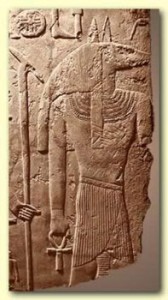It was not unusual in ancient Egypt for more then one god to take the same form, with similar functions as another god. Wepwawet, called the son of Isis, was one of several Egyptian deities to take the form of a canine, today often incorrectly identified as a wolf. Egyptologists now believe that he was more likely associated with the jackal, though he is often depicted with a gray or white head.
 Like Anubis, Wepwawet was also a funerary deity, and was one of the earliest of the gods worshipped at Abydos. Early on, Wepwawet’s worship paralleled that of Khentyamentiu, but when Osiris absorbed that god’s attributes, Anubis filled his funerary role. However, with the rise of the solar cult, particularly during the 12th Dynasty, Osiris was limited to the underworld and the local god and lord of the cemetery at Abydos was filled by Wepwawet, who gained the titles, “Lord of Abydos” and Lord of the Necropolis”. Other cult centers for Wepwawet included Quban, el-Hargarsa, Memphis, Sais and particularly the thirteenth ancient nome of Upper Egypt. This is the location of modern Asyut, which the Greeks called Lycopolis. This may be the origin of the misinterpretation of Wepwawet as a wolf, for Lycopolis can be interpreted as the “Town of the Wolf”.
Like Anubis, Wepwawet was also a funerary deity, and was one of the earliest of the gods worshipped at Abydos. Early on, Wepwawet’s worship paralleled that of Khentyamentiu, but when Osiris absorbed that god’s attributes, Anubis filled his funerary role. However, with the rise of the solar cult, particularly during the 12th Dynasty, Osiris was limited to the underworld and the local god and lord of the cemetery at Abydos was filled by Wepwawet, who gained the titles, “Lord of Abydos” and Lord of the Necropolis”. Other cult centers for Wepwawet included Quban, el-Hargarsa, Memphis, Sais and particularly the thirteenth ancient nome of Upper Egypt. This is the location of modern Asyut, which the Greeks called Lycopolis. This may be the origin of the misinterpretation of Wepwawet as a wolf, for Lycopolis can be interpreted as the “Town of the Wolf”.
Wepwawet’s name means “the opener of the ways (or Roads)”. We believe this refers to his role in leading the deceased through the underworld as a protector. This attribute of the god is well established in New Kingdom funerary texts such as the Book of Going Forth by Day (Book of the Dead), and the Book of That Which Is in the Underworld. Wepwawet was also thought of as the messenger and champion of royalty. Like Shu, he was also referred to as the “one who has separated the sky from the earth. Wepwawet’s image is generally portrayed with a uraeus and a hieroglyph that has been described as representing the king’s placenta, surmounting a standard known as a shedshed. The famous mace of Narmer shows such a standard in use as early as the 1st Dynasty. It is possible, given this context, that early on Wepwawet was a warlike deity and that in war, he also “opened the way” for the Egyptian army. Wepwawet’s standard was carried preceding the king from the palace or temple during processions, and during the New Kingdom, Wepwawet’s standard even preceded that of Osiris.
In fact, Wepwawet’s standard symbolized Upper Egypt in royal processions, while Lower Egypt’s counterpart was the Apis bull of Memphis. However, one inscription provides that he was born in the sanctuary of the goddess Wadjet at Buto in the Nile Delta, though this was most likely politically inspired, considering that all evidence points to his Upper Egyptian origins.